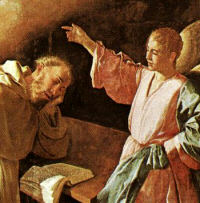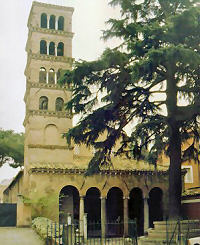Easter: May 6th
Wednesday of the Fifth Week of Easter
Other Commemorations: St. Peter Nolasco, Priest (RM); St. John before the Latin Gate (Hist)
» Enjoy our Liturgical Seasons series of e-books!
According to the 1962 Missal of St. John XXIII the Extraordinary Form of the Roman Rite, today is the feast of St. John before the Latin Gate. A tradition mentioned by St. Jerome, which goes back to the second century, says St. John the Apostle was taken to Rome under the Emperor Domitian and plunged into a cauldron of boiling oil; by a striking miracle he came out safe and sound from this torture. A church dedicated in honor of St. John was built near the Latin Gate, the spot referred to by the tradition.
Historically today is the feast St. Evodius one of the seventy-two disciples Christ, and Catholic tradition has always held that he was the first bishop of Antioch after St. Peter. As bishop of Antioch, he was the first to coin the word “Christian” to refer to the disciples of Jesus. He probably died between the years 64-67, when he was then succeeded by St. Ignatius of Antioch.
St. John before the Latin Gate
One day Salome presented her two sons, James and John, to Jesus, and with a mother’s ambition asked Him to grant them the highest places in his Kingdom. In reply, the Savior spoke of the chalice which He Himself would have to drink, and foretold that these two disciples would also drink of it. The elder, James the Great, was the first to give his Master this proof of his love. John, the younger brother, offered his life in testimony of Jesus’ divinity.
But the martyrdom of the latter Apostle called for a scene worthy of the event. Asia Minor, which his zeal had evangelized, was not a sufficiently glorious land for such a combat. Rome, whither Peter had transferred his Chair and where he died on his cross, and where Paul had bowed down his venerable head beneath the sword, alone deserved the honor of seeing the beloved disciple march on to martyrdom, with that dignity and sweetness which are the characteristics of this veteran of the Apostolic College.
In the year 95 John appeared before the tribunal of pagan Rome. He was convicted of having propagated, in a vast province of the Empire, the worship of a Jew who had been crucified under Pontius Pilate. He was considered a superstitious and rebellious old man, and it was time to rid Asia of his presence. He was, therefore, sentenced to an ignominious and cruel death.
A huge cauldron of boiling oil was prepared in front of the Latin Gate. The sentence ordered that the preacher of Christ be plunged into this bath. The hour had come for the second son of Salome to partake of his Master’s chalice. John’s heart leapt with joy. After cruelly scourging him, the executioners seized the old man, and threw him into the cauldron. But, lo! the boiling liquid lost all its heat; the Apostle felt no scalding. On the contrary, when they took him out again he felt all the vigor of his youthful years restored to him.
The praetor’s cruelty was foiled, and John, a martyr in desire, was to be left to the Church for some few years longer. An imperial decree banished him to the rugged Isle of Patmos, where God revealed to him the future of the Church even to the end of time.
—Excerpted from The Liturgical Year, Abbot Gueranger O.S.B.
Highlights and Things to Do:
- Although not longer a feast on our current liturgical calendar, the tradition still remains. The chapel in Rome opens up once a year for this feast day:
St. Peter Nolasco
 One night while Peter Nolasco was praying, the Blessed Virgin appeared (1228) and told him how greatly pleased she and her divine Son would be if a religious order were established in her honor for the express purpose of delivering Christians held in bondage by the infidels. In compliance with her wish, Peter, together with St. Raymond of Penafort and James I, King of Aragon, founded the Order of Our Lady of Mercy for the ransom of captives. Besides the usual vows, all members were required to take a fourth, one by which they bound themselves to become captives of the pagans, if necessary, to effect the emancipation of Christians.
One night while Peter Nolasco was praying, the Blessed Virgin appeared (1228) and told him how greatly pleased she and her divine Son would be if a religious order were established in her honor for the express purpose of delivering Christians held in bondage by the infidels. In compliance with her wish, Peter, together with St. Raymond of Penafort and James I, King of Aragon, founded the Order of Our Lady of Mercy for the ransom of captives. Besides the usual vows, all members were required to take a fourth, one by which they bound themselves to become captives of the pagans, if necessary, to effect the emancipation of Christians.
On one occasion Peter Nolasco ransomed 400 at Valencia and Granada; twice he traveled to Africa as "the Ransomer," not without peril to his own life; and records show that through his personal efforts a total of 890 Christians regained their liberty. He died with these words from Psalm 110 on his lips: The Lord has sent redemption to His people.
—Excerpted from The Church's Year of Grace, Pius Parsch
Highlights and Things to Do:
- Read more about St. Peter:
- See St. Peter's statue in the St. Peter's Basilica Colonnade and the Founder Statue in St. Peter's Basilica.
- To find out more about the history of the Mercedarian Order read this account.








